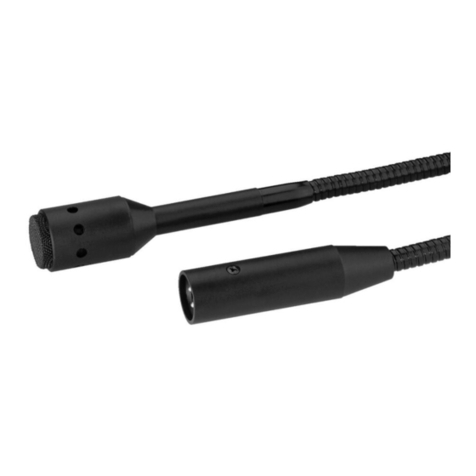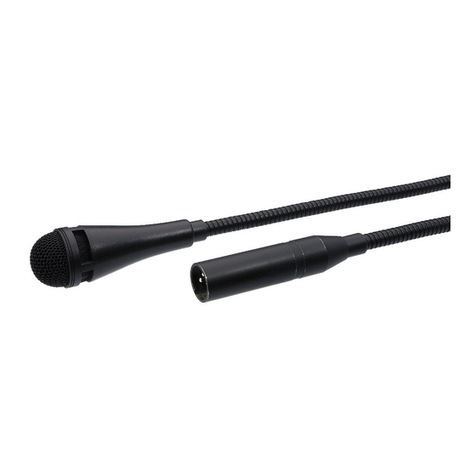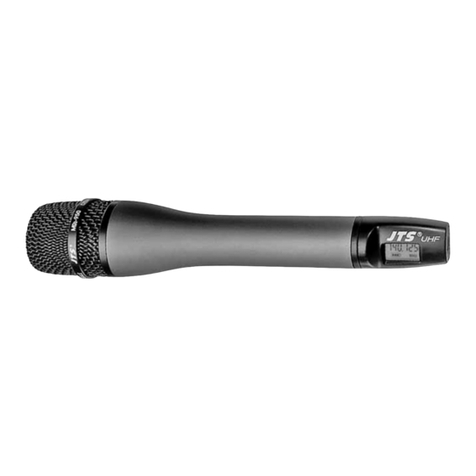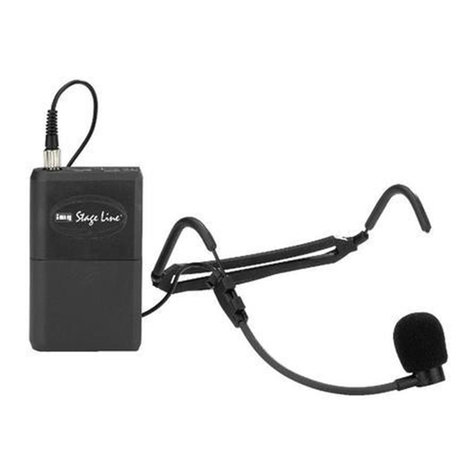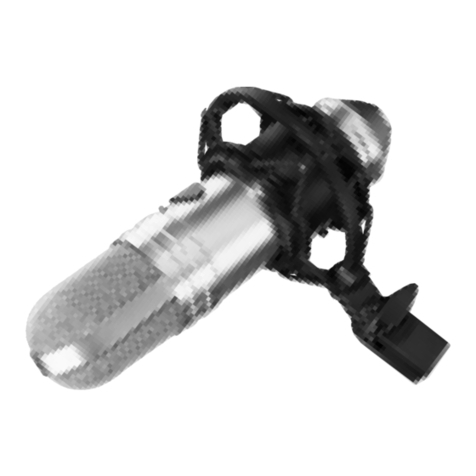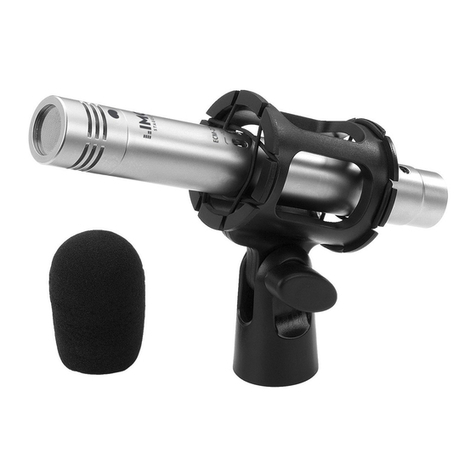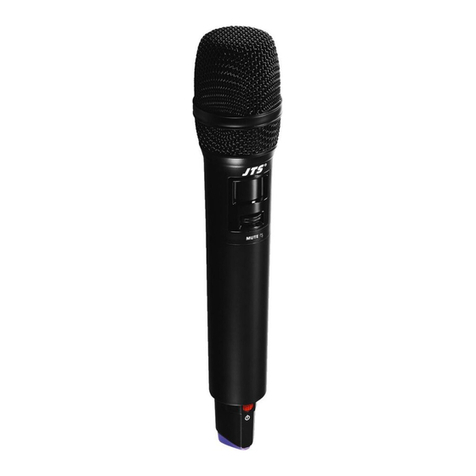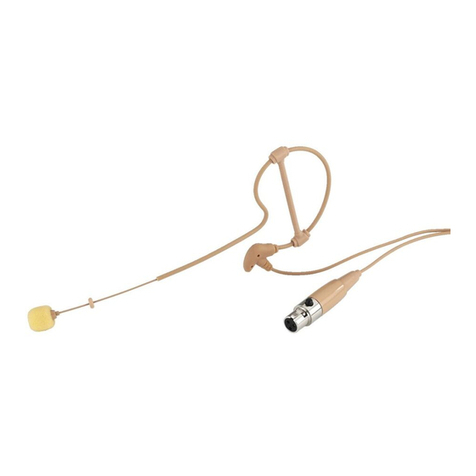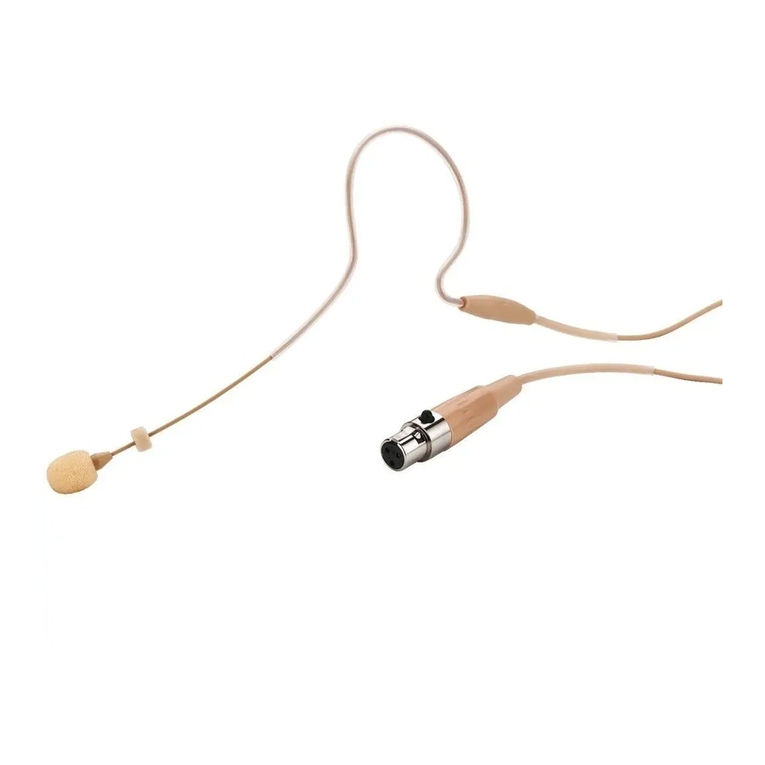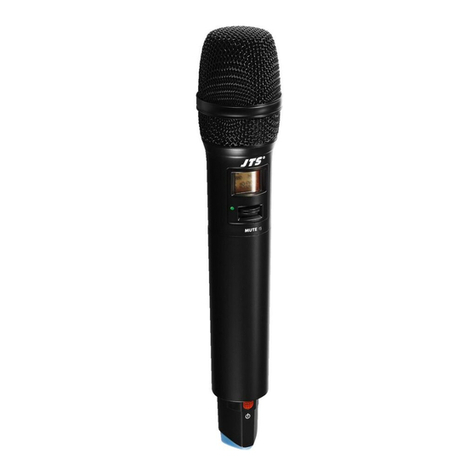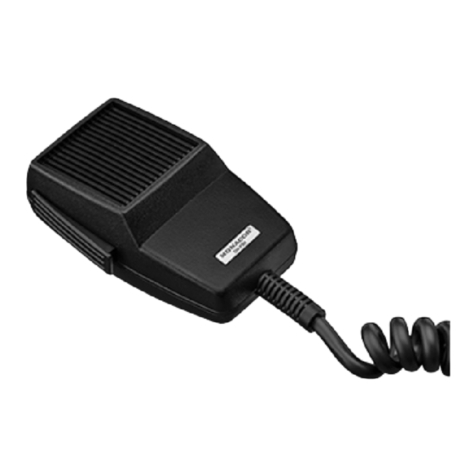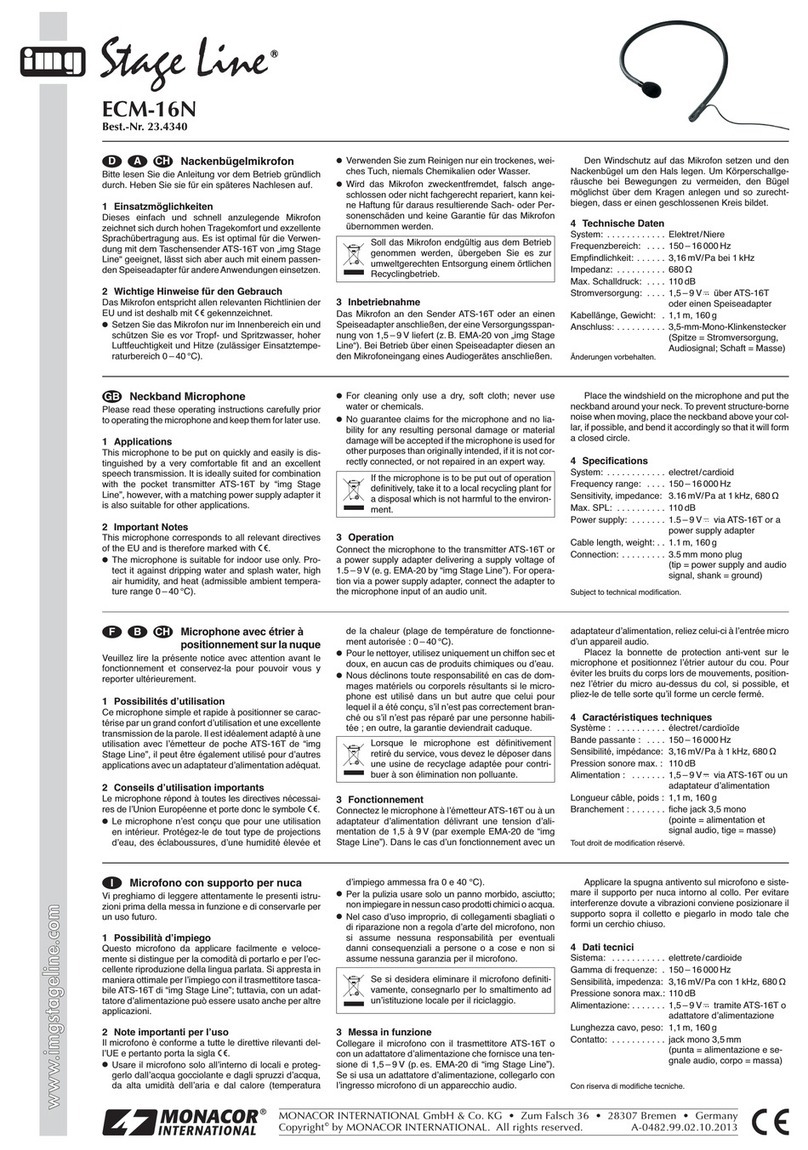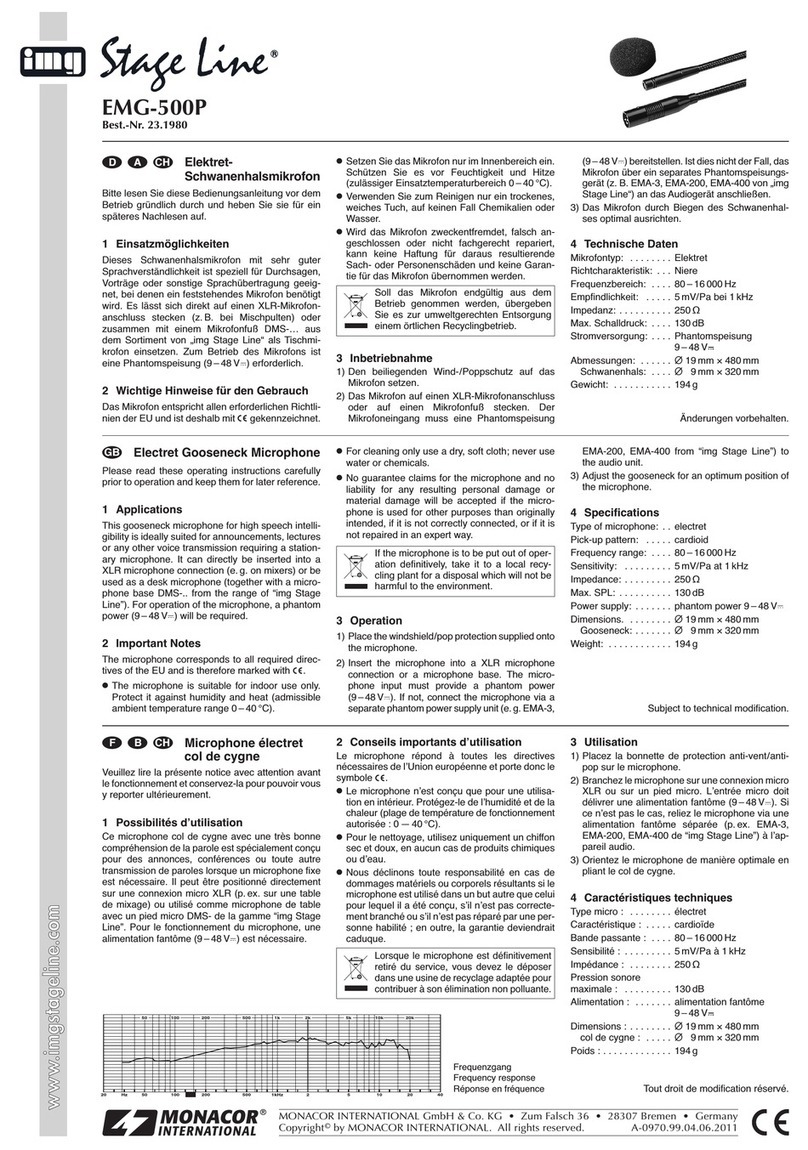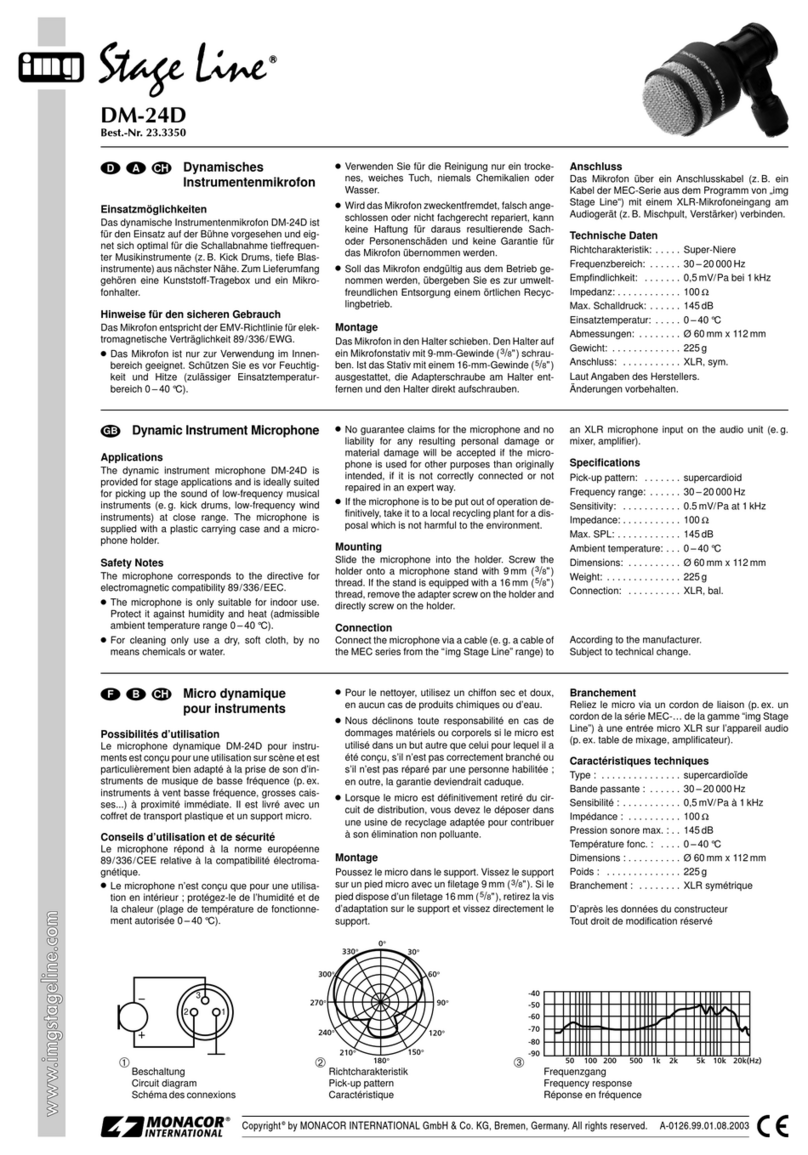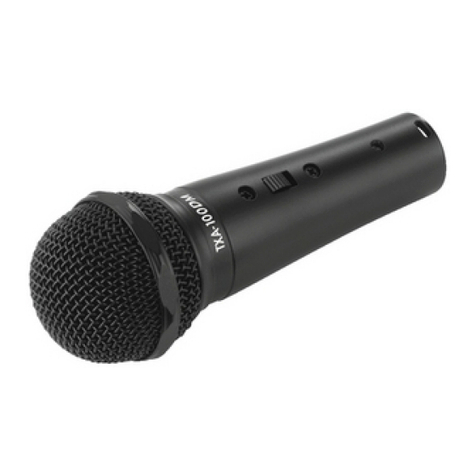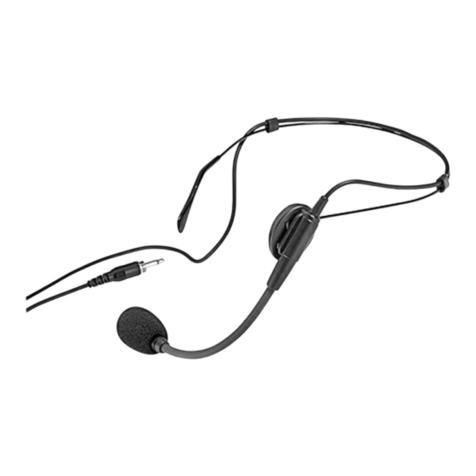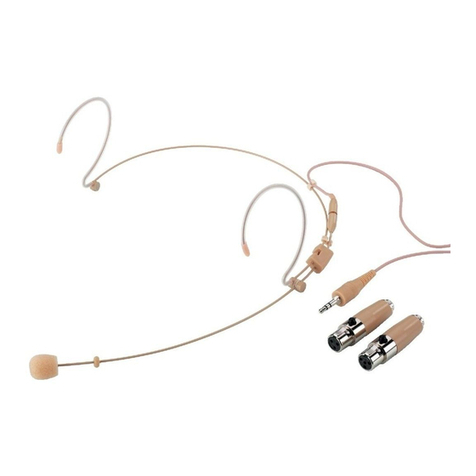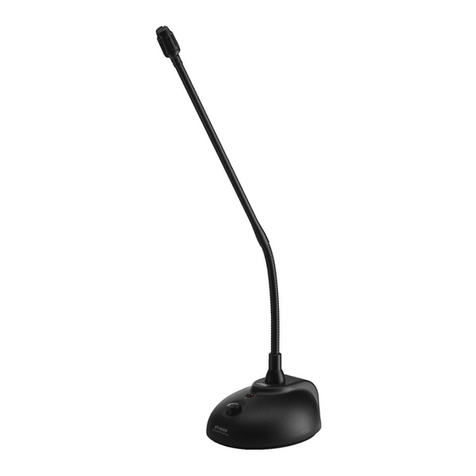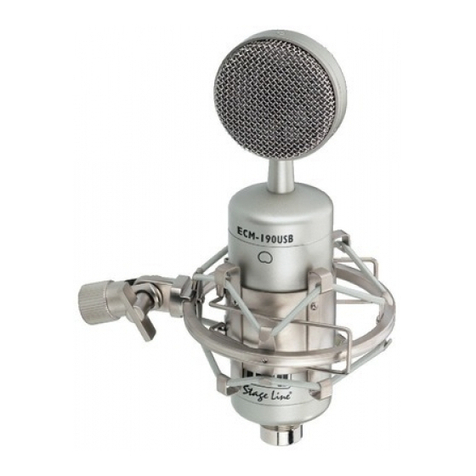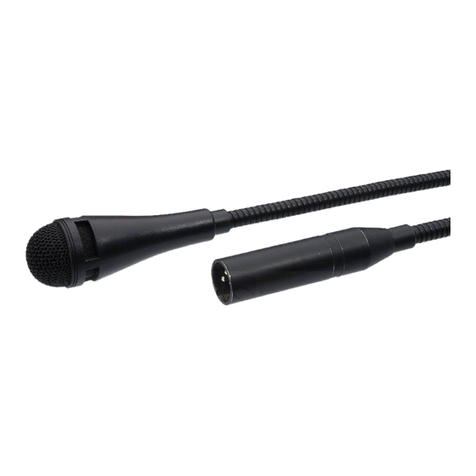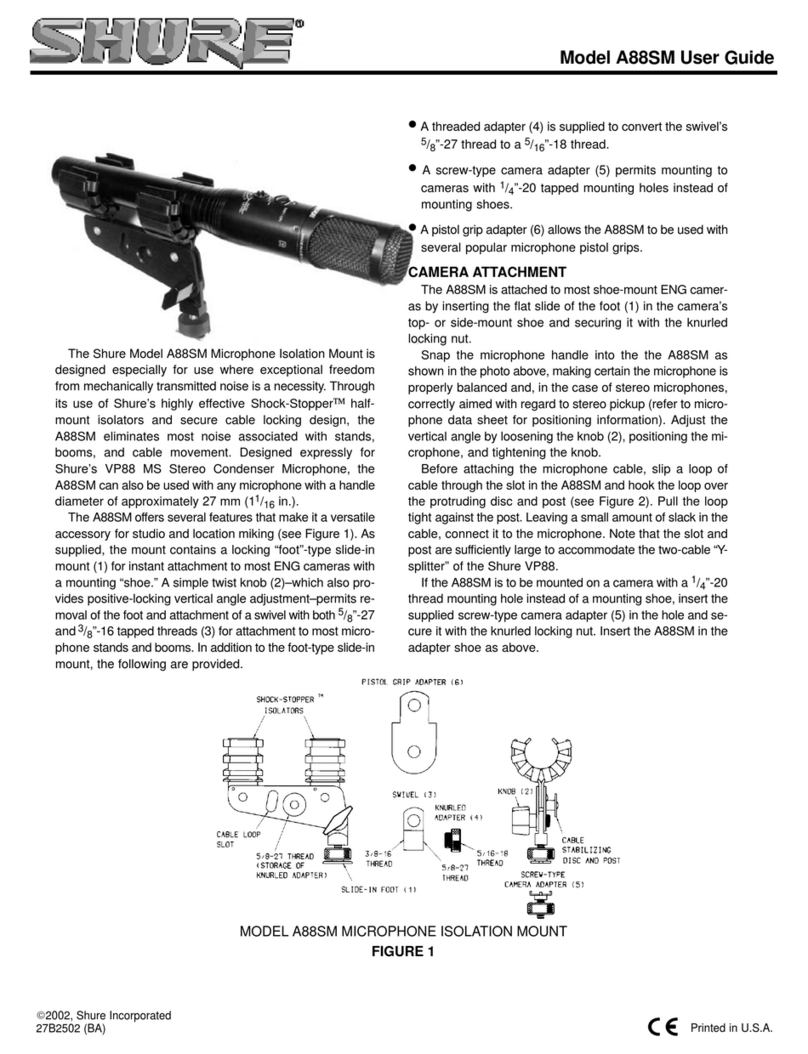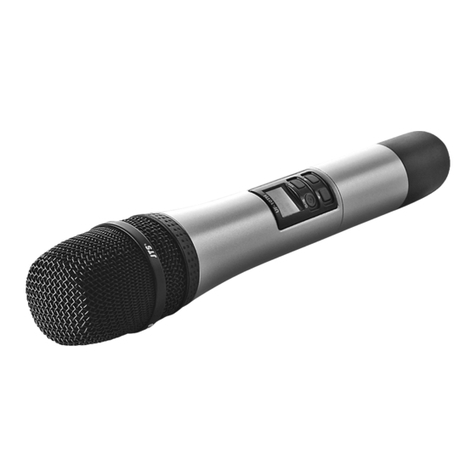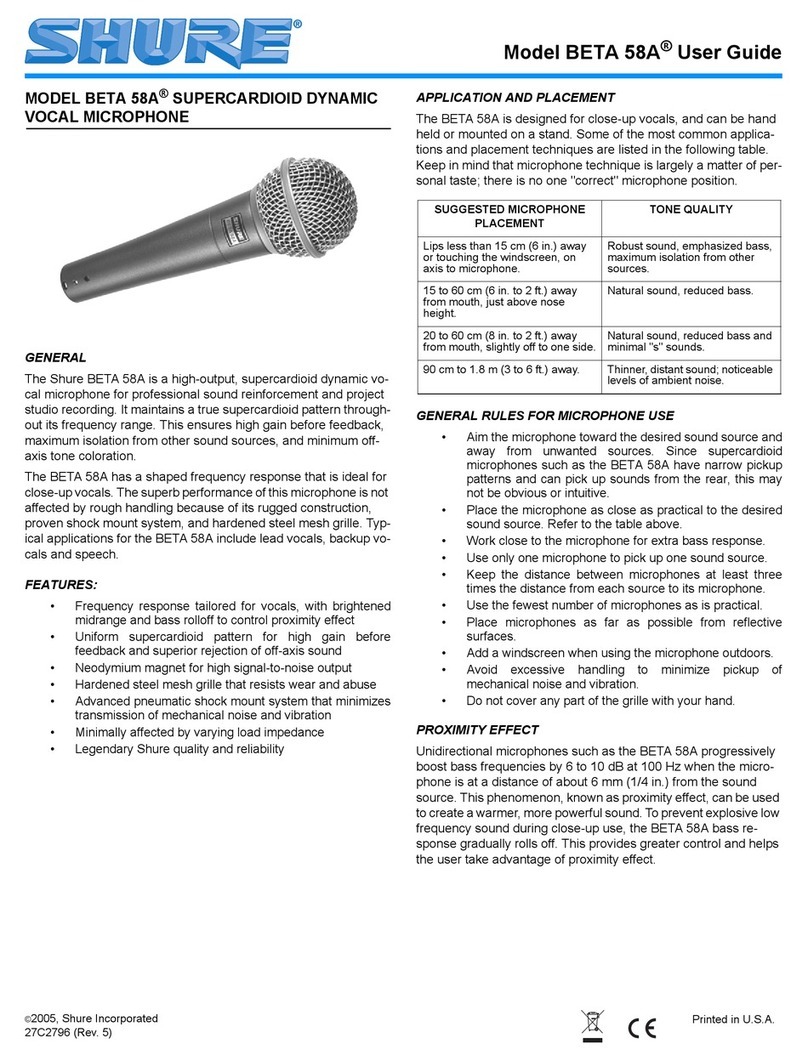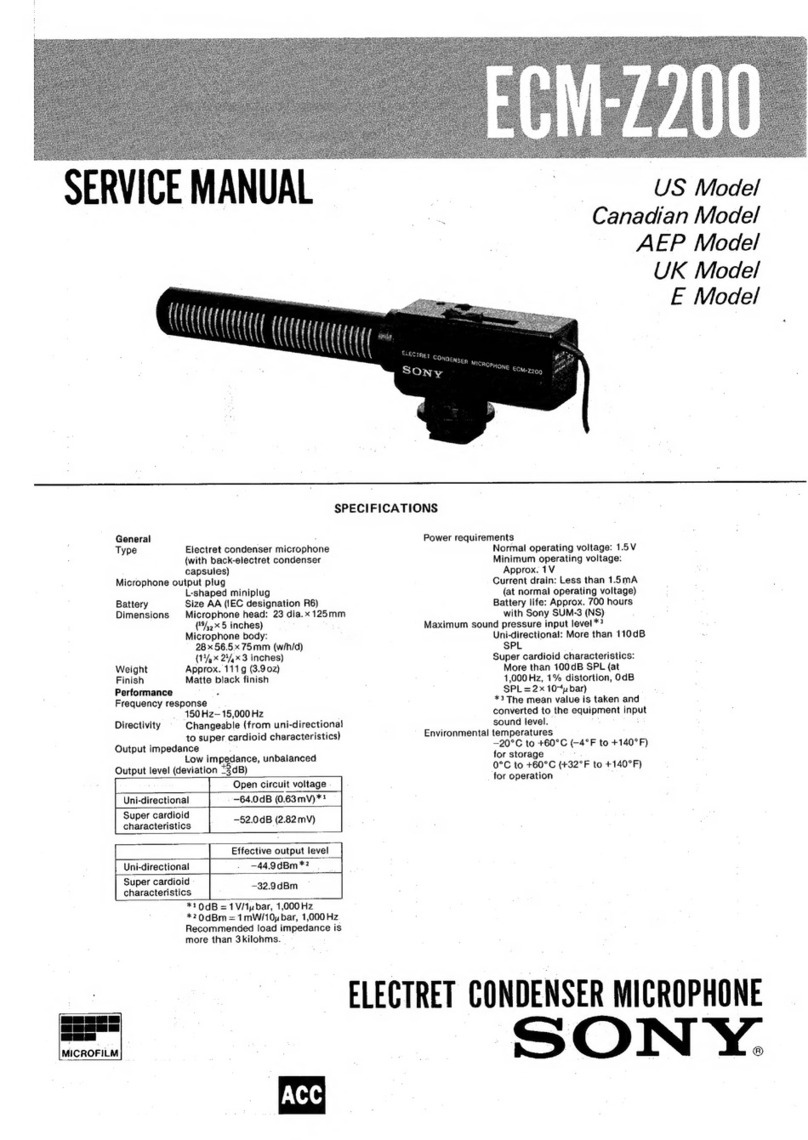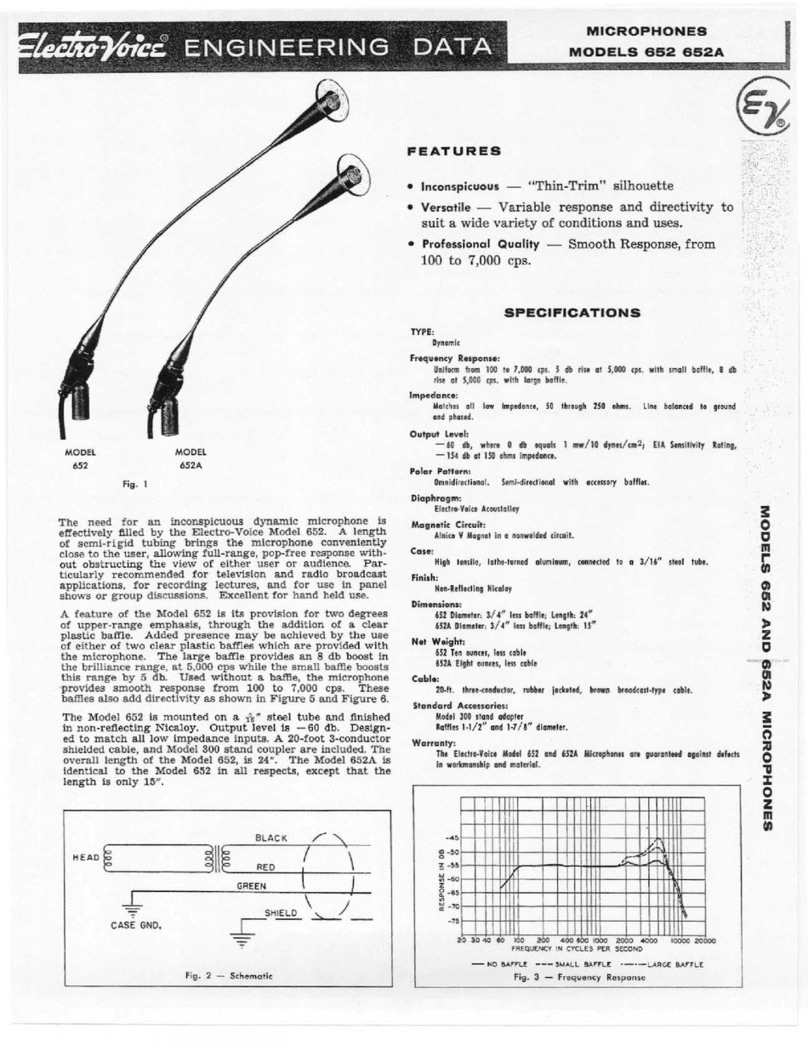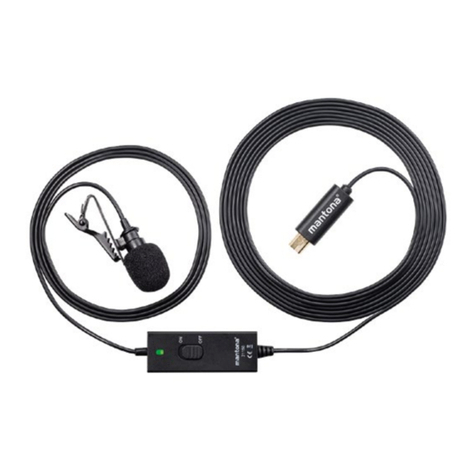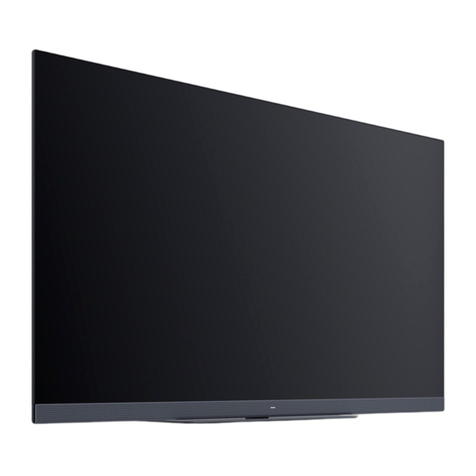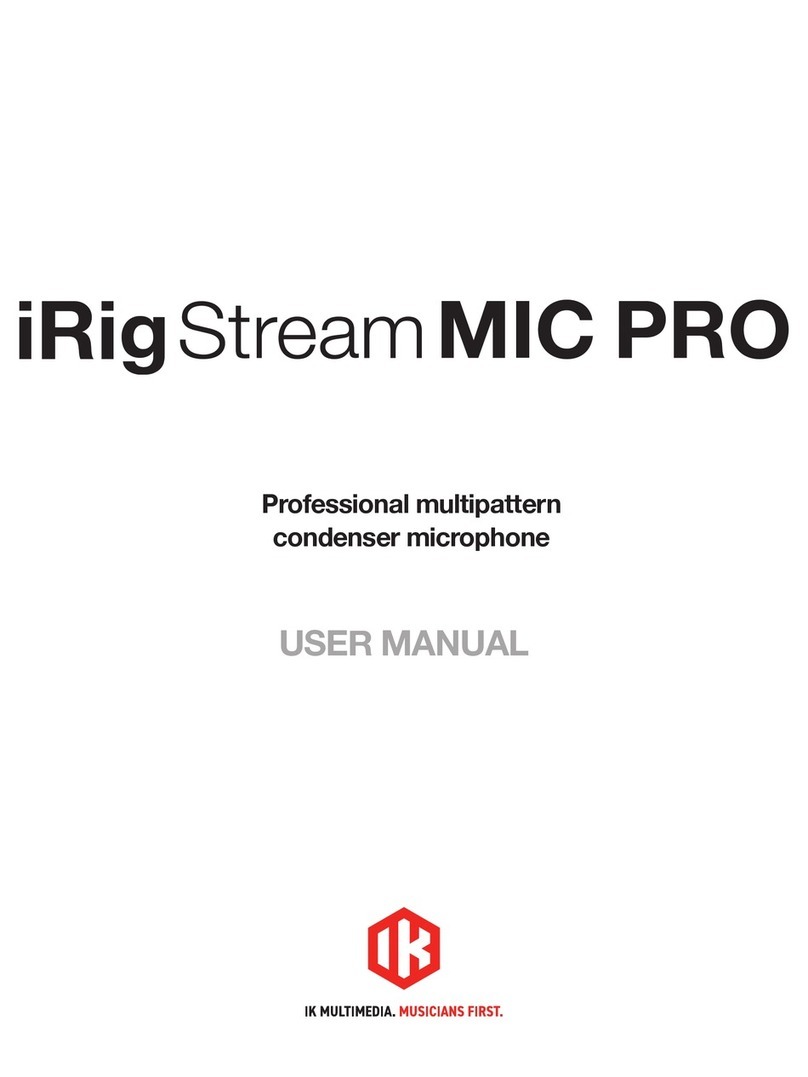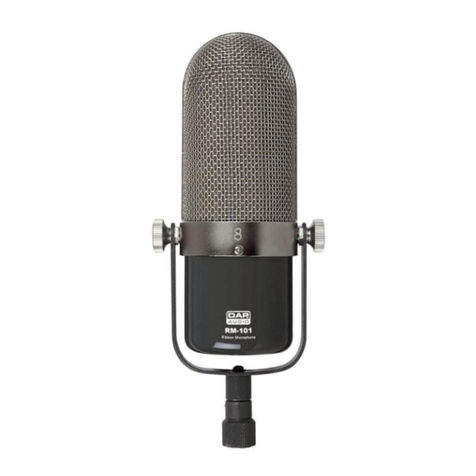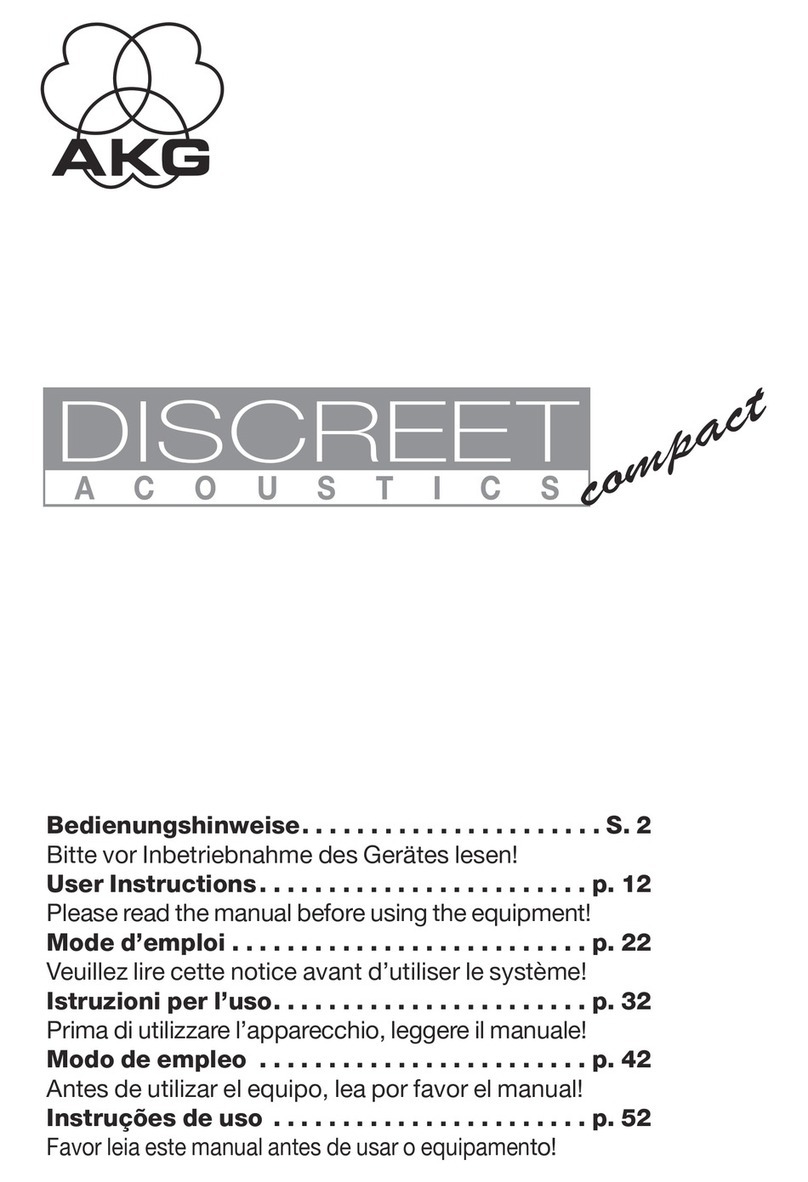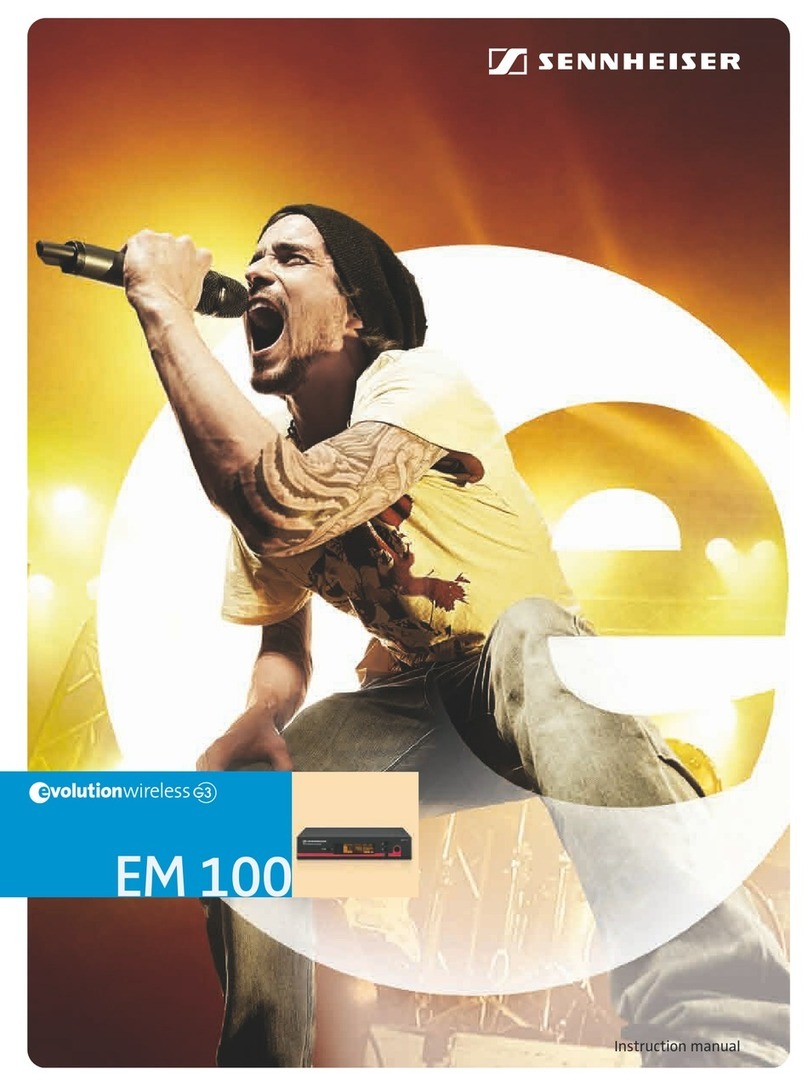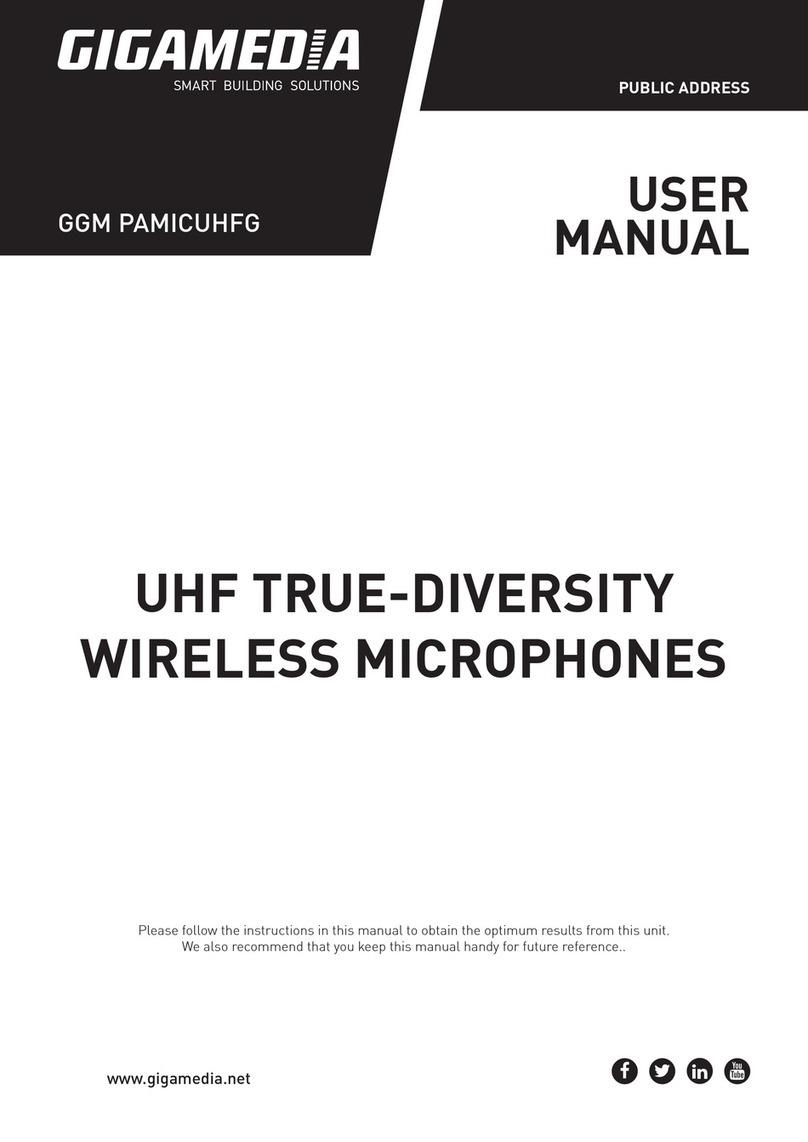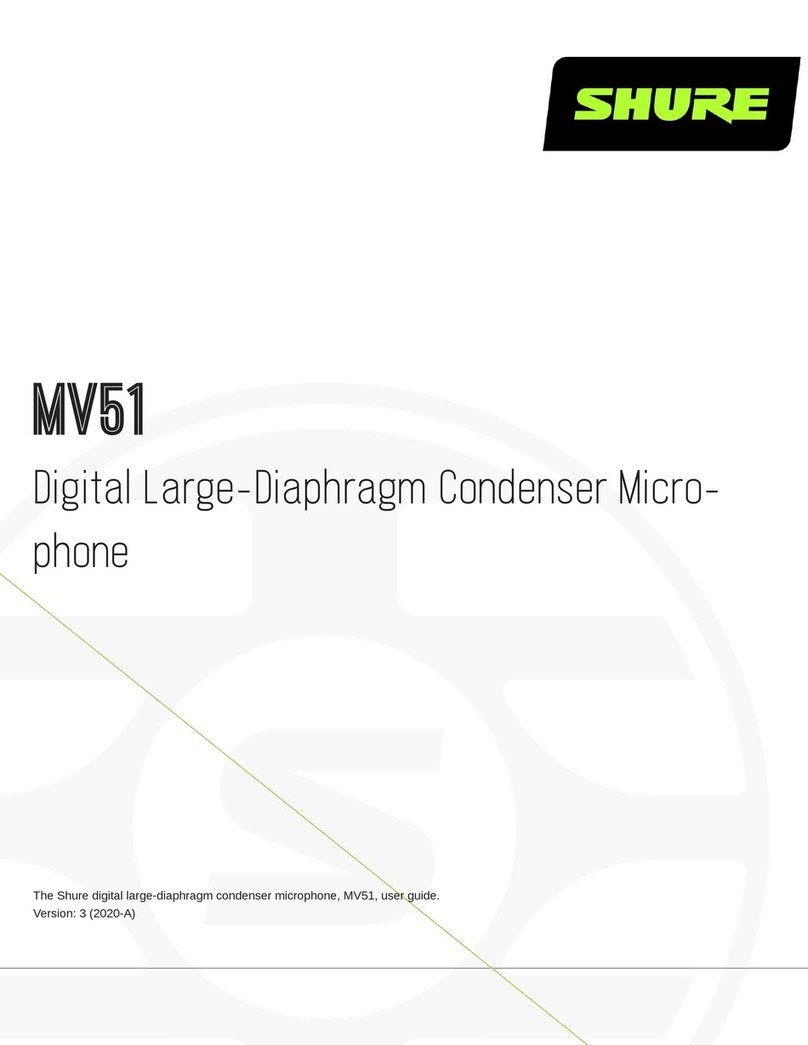wwwwww..iimmggssttaaggeelliinnee..ccoomm
Copyright©by MONACOR INTERNATIONAL GmbH & Co. KG, Bremen, Germany. All rights reserved. A-0506.99.01.10.2005
®
Microfono archetto
Vipreghiamo dileggere attentamentele presenti istru-
zioni prima della messa in funzione e di conservarle
per un uso futuro.
1 Possibilità d’impiego
Questo microfono archetto mini, estremamente leg-
gero e non vistoso, è adatto in modo ottimale per
applicazioni di canto e di lingua parlata che richiedono
molta libertà di movimento. Per il funzionamento è
richiestoun adattatore dialimentazione (p.es. EMA-1,
EMA-2, EMA-40, EMA-300P) oppure, per la trasmis-
sione audio senza fili, un trasmettitore tascabile
(TXS-...HSE) di “img Stage Line”.
2 Note importanti per l’uso
Il microfono è conforme a tutte le direttive richieste
dell’UE e pertanto porta la sigla .
●Far funzionare il microfono solo all’interno di locali e
proteggerlo dall’umidità e dal calore (temperatura
d’impiego ammessa fra 0 e 40°C).
●Per la pulizia usare solo un panno morbido, asciut-
to; non impiegare in nessun caso prodotti chimici o
acqua.
●Nel caso d’uso improprio, di collegamenti sbagliati o
di riparazione non a regola d’arte del microfono, non
si assume nessuna responsabilità per eventuali
danni consequenziali a persone o a cose e non si
assume nessuna garanzia per lo strumento.
3 Messa in funzione
Sistemare la spugna antivento sul microfono. Posizio-
nare l’archetto sull’orecchio sinistro in modo che il sup-
portoprema daldidietro sullobo, eportareil microfono
vicino alla bocca, in posizione opportuna per parlare.
Inserire la presa mini XLR del cavo microfono nella
presa d’ingresso del trasmettitore tascabile oppure
dell’adattatore di alimentazione. Se si usa un adatta-
tore di alimentazione, collegarlo con l’ingresso micro-
fono di un apparecchio audio.
Se si desidera eliminare il microfono de-
finitivamente, consegnarlo per lo smalti-
mento ad un’istituzione locale per il rici-
claggio.
Micrófono de oreja
Por favor, lea estas instrucciones atentamente antes
de su uso y guárdelas para usos posteriores.
1 Usos
Este micrófono de oreja miniatura, discreto y extra
ligero, es ideal para el sonido de canto y para apli-
caciones de discurso que requieren mucha libertad
de movimiento. Para su funcionamiento también es
necesario un adaptador de alimentación (por ejem-
plo el EMA-1, EMA-2, EMA-40, EMA-300P) o, para
transmisión audio inalámbrica, un emisor de petaca
(TXS-...HSE) de “img Stage Line”.
2 Notas importantes para el uso
El micrófono responde a todas las normativas reque-
ridas por la CEE y por ello está marcado con .
●El micrófono solo está indicado para un uso en inte-
rior. Protéjalo de la humedad y del calor (tempera-
tura ambiente admisible: 0–40°C).
●Para limpiar use sólo un paño seco y suave, no uti-
lice productos químicos o agua.
●No se asumirá ninguna garantía para el micrófono
ni se aceptará responsabilidad alguna en caso de
daños personales o materiales producidos si el
micrófono se usa con fines distintos a aquel para el
que fue fabricado, si no está correctamente conec-
tado, o si no es reparado de manera experta.
3 Puesta en marcha
Coloque la protección anti-viento en el micrófono.
Ponga el sistema de enganche de oreja en la oreja
izquierda para que el soporte quede presionado con-
tra la oreja por detrás y coloque el micrófono cerca de
la boca en una posición adecuada para hablar.
Conecte la toma mini XLR del cable a la toma de
entrada del transmisor de petaca o del adaptador de
alimentación. Cuando use un adaptador de alimen-
tación, conéctelo a la entrada del micrófono de un
aparato audio.
Si el micrófono es retirado del funciona-
miento definitivamente, llévelo a un centro
de reciclaje para su eliminación no conta-
minante para el medio ambiente.
Mikrofon nauszny
Prosimy o uważne przeczytanie poniższej instrukcji
przed użyciem urządzenia, oraz o zachowanie tekstu
do wglądu.
1Zastosowanie
Elektretowy mikrofon nauszny HSE 60/SK jest niez
wykle mały i lekki, co sprawia, że znajduje idealne
zastosowanie tam, gdzie konieczna jest duża swo
boda ruchu. Mikrofon działa w połączeniu z adapte
rem zasilania (np. EMA 1, EMA 2, EMA 40, EMA
300P z oferty firmy “img Stage Line”) lub do transmisji
bezprzewodowej z nadajnikiem kieszonkowym (np.
TXS ...HSE z oferty firmy “img Stage Line”).
2Bezpieczeństwo użytkowania
Ponieważ urządzenie spełnia wymogi obowiązujące
w Unii Europejskiej, jest oznaczone symbolem .
●Urządzenie przeznaczone jest do użytku tylko
wewnątrz pomieszczeń. Należy chronić je przed
działaniem wody, wilgoci oraz wysokiej tempera
tury (dopuszczalny zakres temperatury otoczenia
pracy to 0– 40°C).
●Do czyszczenia urządzenia należy używać suchej,
miękkiej tkaniny, nie wolno używać wody ani che
micznych środków czyszczących.
●Nie ponosi się odpowiedzialności za wynikłe usz
kodzenia sprzętu lub obrażenia użytkownika w
przypadku, gdy urządzenie jest wykorzystywane w
innych celach niż to się przewiduje, jeśli jest nie
prawidłowo podłączone, lub jeśli nie jest napra
wiane przez specjalistę.
3Przygotowanie do pracy
Należy nałożyć na mikrofon osłonę przeciwwietrzną.
Następnie należy założyć mikrofon na lewe ucho tak,
aby element zauszny mocno przylegał do skóry, oraz
ustawić mikrofon w optymalnej pozycji, blisko ust.
Następnie należy podłączyć gniazdo nakablowe
typu mini XLR do gniazda nadajnika kieszonkowego
lub adaptera zasilania (adapter zasilania należy
następnie połączyć z wejściem mikrofonowym
urządzenia audio).
Jeśli urządzenie ma zostać ostatecznie
wycofane z użycia, należy przekazać je do
punktu utylizacji odpadów, aby uniknąć
zanieczyszczenia środowiska.
4Dane techniczne
Typ, charakterystyka: . . elektretowy typu “back”,
dookólny
Pasmo przenoszenia: . . 20 – 20 000 Hz
Opór: . . . . . . . . . . . . . . 2 kΩ
Czułość: . . . . . . . . . . . . 5,6 mV/Pa przy 1 kHz
Maks. SPL: . . . . . . . . . . 140 dB
Stosunek S/N: . . . . . . . > 60 dB
Zasilanie: . . . . . . . . . . . . 1,5 – 9 V przez adapter
zasilania lub nadajnik kies
zonkowy
Waga: . . . . . . . . . . . . . . . 1 g (bez kabla)
Połączenie: . . . . . . . . . . kabel 1,2 m z 3 pinowym
gniazdem nakablowym XLR
Akcesoria: . . . . . . . . . . . gąbka przeciwwietrzna,
pokrowiec
1 = masa
2 = sygnał
3 = zasilanie
Producent zastrzega sobie prawo do zmian technicz
nych.
